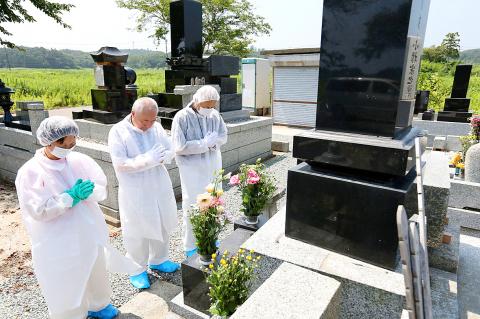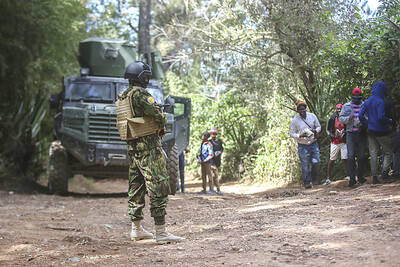The most ambitious radiation clean-up ever attempted has proved costly, complex and time-consuming since the Japanese government began it more than two years in the wake of the Fukushima Dai-ichi nuclear power plant meltdown. It may also fail.
Doubts are mounting that the effort to decontaminate hotspots in an area the size of Connecticut will succeed in its ultimate aim — luring more than 100,000 nuclear evacuees back home. If thousands of former residents cannot or will not return, parts of the farming and fishing region could remain an abandoned wilderness for decades.
In many areas, radiation remains well above targeted levels because of bureaucratic delays and ineffective work on the ground. As a result, some experts fear the US$15 billion allocated to the scheme so far will be largely squandered.

Photo: AFP
The deep-seated problems facing the clean-up are both economic and operational, according to a Reuters review of decontamination contracts and interviews with dozens of workers, managers and officials involved.
In Kawauchi, a heavily forested village in Fukushima Prefecture, decontamination crews have finished cleaning up houses, but few of their former inhabitants are prepared to move back. Just over 500 of the 3,000 people who once lived here have returned since the March 2011 meltdown at the Fukushima nuclear plant 25km to the east.
Even after being deemed safe enough for people to return, Kawauchi has no functioning hospital or high school.
The mushrooms that used to provide a livelihood for foragers are now steeped in dangerous levels of caesium. The only jobs on offer in town are menial. Some houses are so mildewed after three summers of abandonment that they need to be torn down.
The village has not only shrunk; its population has also aged. While the elderly used to make up a third of the town, they now account for 70 percent of residents.
The same pattern has played out across Fukushima as the nuclear accident turned the slow drip of urban flight by younger residents into a torrent, creating a demographic skew that decontamination is unlikely to reverse.
Kawauchi is one of the 11 townships that were most heavily contaminated after the accident, when rain and snow showered radioactive particles onto the verdant hills as the plume from the plant passed overhead. Half of it lies in the still-evacuated area where the national government has assumed control of the clean-up.
“There is no comprehensive plan on how to rebuild the village,” said Yasutsugu Igari, 34, who works in the reconstruction department at Kawauchi’s village office. “It’s the government that destroyed it, but now it’s doing very little to help us recreate our lives.”
Masayoshi Yokota, who is in charge of decontamination, says he has heard that frustration before.
“First they said they wouldn’t come back unless we decontaminated. So we did that and told them they could come back, but then it was about jobs or that they didn’t want to come back because they have children,” he said.
Japan’s plan to scrub clean the area around Fukushima and remove radioactive debris was beset by difficulties from the beginning.
Nothing on the same scale had ever been attempted before. After the Chernobyl accident in 1986, highly contaminated houses were entombed in concrete and the surrounding area was abandoned.
By contrast, Japan’s government is attempting to bring background radiation levels in the most highly contaminated evacuation zone to an average of 1 millisievert per year once all the work is completed.
That would be twice the background radiation level in Denver, or a sixth of the annual dose for the average American when all sources or radiation are taken into account. Japanese nuclear workers are limited to an accumulative exposure of 100 millisieverts over five years. Although radiation health experts assume that any incremental exposure to radiation increases risks for later cancers, the International Atomic Energy Agency say a statistically significant correlation only shows up at doses over that higher threshold.
The Japanese government decided to allow people to move back to areas with an average annual dose of less than 20 millisieverts in December 2011.
In an attempt to reach the tougher radiation target, thousands of temporary workers have been put to work scrubbing houses and roads, digging up topsoil and stripping trees of leaves into which invisible caesium particles have wormed.
Few of the hundreds of companies and small firms involved have any experience with radiation. Some workers have said they have been told to flush contaminated leaves away in rivers by supervisors to speed the job up and reduce waste, since storage remains a problem.
On a recent Saturday, a crew of 10 workers in jumpsuits, hardhats and surgical masks were clearing a roadside outside Kawauchi, picking up leaves and trimming weeds. The lower half of nearby forest slopes were stripped of saplings and shrubbery.
“That’s lovely,” Yokota told a visitor. “They’ve got it nice and clean.”
Some experts are doubtful about the payback of that effort.
“The truth of the matter is that from the European experience [after Chernobyl], remediation factors are disappointing,” said David Sanderson, a professor of environmental science at the University of Glasgow and an expert in radiation who has made numerous trips to Fukushima to map the fallout.

A fire caused by a burst gas pipe yesterday spread to several homes and sent a fireball soaring into the sky outside Malaysia’s largest city, injuring more than 100 people. The towering inferno near a gas station in Putra Heights outside Kuala Lumpur was visible for kilometers and lasted for several hours. It happened during a public holiday as Muslims, who are the majority in Malaysia, celebrate the second day of Eid al-Fitr. National oil company Petronas said the fire started at one of its gas pipelines at 8:10am and the affected pipeline was later isolated. Disaster management officials said shutting the

DITCH TACTICS: Kenyan officers were on their way to rescue Haitian police stuck in a ditch suspected to have been deliberately dug by Haitian gang members A Kenyan policeman deployed in Haiti has gone missing after violent gangs attacked a group of officers on a rescue mission, a UN-backed multinational security mission said in a statement yesterday. The Kenyan officers on Tuesday were on their way to rescue Haitian police stuck in a ditch “suspected to have been deliberately dug by gangs,” the statement said, adding that “specialized teams have been deployed” to search for the missing officer. Local media outlets in Haiti reported that the officer had been killed and videos of a lifeless man clothed in Kenyan uniform were shared on social media. Gang violence has left

US Vice President J.D. Vance on Friday accused Denmark of not having done enough to protect Greenland, when he visited the strategically placed and resource-rich Danish territory coveted by US President Donald Trump. Vance made his comment during a trip to the Pituffik Space Base in northwestern Greenland, a visit viewed by Copenhagen and Nuuk as a provocation. “Our message to Denmark is very simple: You have not done a good job by the people of Greenland,” Vance told a news conference. “You have under-invested in the people of Greenland, and you have under-invested in the security architecture of this

Japan unveiled a plan on Thursday to evacuate around 120,000 residents and tourists from its southern islets near Taiwan within six days in the event of an “emergency”. The plan was put together as “the security situation surrounding our nation grows severe” and with an “emergency” in mind, the government’s crisis management office said. Exactly what that emergency might be was left unspecified in the plan but it envisages the evacuation of around 120,000 people in five Japanese islets close to Taiwan. China claims Taiwan as part of its territory and has stepped up military pressure in recent years, including